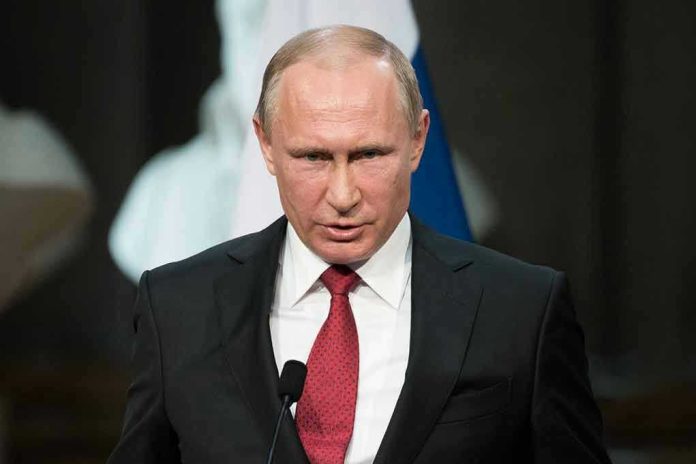
Russia’s recent missile test signals a chilling advancement in nuclear capabilities, raising the stakes in the Ukraine conflict.
Story Highlights
- Russia successfully tests the Burevestnik missile, claiming unmatched capabilities.
- Test serves as a strategic message amid the ongoing Ukraine conflict.
- Western nations express concern over potential escalation and nuclear risks.
- Putin positions the missile as a response to sanctions and military pressure.
Russia’s Missile Test: A Strategic Signal
Russian President Vladimir Putin’s announcement of the successful test of the Burevestnik missile has captured global attention. This nuclear-powered, nuclear-capable cruise missile reportedly flew 14,000 kilometers over 15 hours, a feat that emphasizes its purported invincibility and unlimited range. The timing is significant, as tensions with Ukraine and Western nations continue to simmer. Russian officials use this demonstration to project strength, suggesting the missile’s development is a direct response to ongoing military and economic pressures.
The test location, near Novaya Zemlya in the Arctic, is historically associated with Russian nuclear trials, underscoring the seriousness of Russia’s military message. The missile’s nuclear propulsion system theoretically allows for unpredictable flight paths, complicating interception efforts. This development adds a new dimension to the geopolitical landscape, as the West grapples with the implications of Russia’s advanced military technology.
Historical Context and Precedents
The Burevestnik missile project stems from 2018 when Putin unveiled a suite of new strategic weapons aimed at circumventing U.S. missile defenses. Despite initial setbacks, including a fatal accident in 2019, Russia has persisted in its development, driven by a need to assert technological and military dominance. This persistence reflects a broader strategic goal of deterring Western intervention and showcasing Russian resilience in the face of sanctions and isolation.
The missile’s successful test during the Ukraine-Russia conflict is not merely a military achievement but a calculated move in the chess game of international relations. It serves as a reminder of Russia’s capability to innovate and challenge existing defense paradigms, even amidst internal and external challenges.
International Reactions and Concerns
The international community, particularly the United States and NATO, has responded with concern. U.S. President Trump publicly criticized the test’s timing, urging Putin to pivot towards resolving the Ukraine conflict rather than escalating military posturing. The presence of U.S. Air Force WC-135 aircraft in the region suggests active monitoring for potential nuclear activity, highlighting the gravity with which the test is viewed.
While Russia portrays the missile as a defensive necessity, Western nations see it as provocative and destabilizing. The test exacerbates fears of a renewed arms race, with implications for global nuclear arms control efforts. The potential for miscalculation or accidents only adds to the anxiety surrounding this development.
Implications for Global Security and Policy
In the short term, this missile test heightens tensions and scrutiny on Russia’s military actions, potentially accelerating Western defense measures. Long-term implications are more profound, risking a shift in nuclear arms race dynamics and challenging existing arms control treaties. These developments necessitate a reevaluation of global security strategies and diplomatic engagements.
For Russia, the successful test may bolster domestic support and solidify its narrative of technological superiority. However, it also risks further economic sanctions and international isolation. For the West, the challenge lies in balancing deterrence with diplomacy, preventing escalation while addressing legitimate security concerns.













